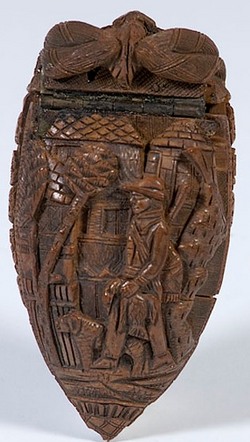Tagua Nuts
Tagua nuts are the endosperm of a genus of South American palm trees that are found from Panama down through Bolivia and Peru. Tagua nuts, or more accurately, the kernels of tagua seeds, are left behind by the wildlife that feed on the palm’s fruit. The group of palms is often referred to as “tagua palms” or “ivory-nut palms,” because tagua nuts are so hard, they resemble elephant ivory. (In fact, the scientific name given to these plants translates as “plant elephant.”)

A tagua nut snuff box with a carved scene of a hunter and his dog. (p4A item # D9676071)
Elephant ivory has long been either expensive, difficult or simply distasteful to possess, and thus tagua nuts have often been used as an acceptable substitute. The nuts take dye relatively well, and can be carved just like ivory for beads, buttons, and other small decorative objects. The nuts shrink as they dry and harden, and occasionally, small cavities will form inside them. Since there’s no way to know whether or not a tagua nut will have a cavity before carving, carvings that use the whole nut are typically extremes – either very deep with designs that allow for the possibility or flatter and more shallow relief decoration.
Hollie Davis, p4A Senior Editor, August 11, 2009
